Martand Sun Temple: Where Sunbeams Kiss Stone
The Martand Sun Temple is a Hindu temple dedicated to Surya (the chief solar deity in Hinduism) and built during the 8th century CE. It is located in the Anantnag district of Jammu and Kashmir, India. The temple is now in ruins, as it was destroyed by the orders of Muslim ruler Sikandar Shah Miri.
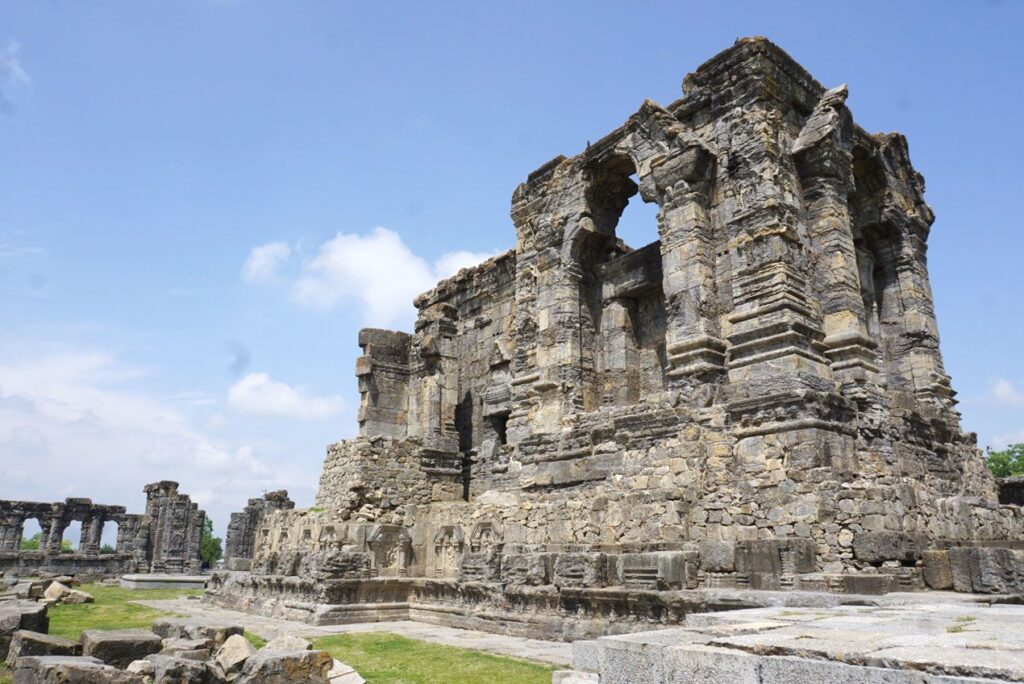
Contents
- 1 Martand Sun Temple History:
- 2 Legend of Martand Sun Temple:
- 3 Significance of Martand Sun Temple:
- 4 Martand Sun Temple Architecture:
- 5 Places to visit near Martand Sun Temple:
- 6 FAQ:
- 6.0.1 What is the Martand Sun Temple?
- 6.0.2 Who built the Martand Sun Temple?
- 6.0.3 What happened to the Martand Sun Temple?
- 6.0.4 Is the Martand Sun Temple open to the public?
- 6.0.5 What are the best times to visit the Martand Sun Temple?
- 6.0.6 What is there to see at the Martand Sun Temple?
- 6.0.7 What are some things to keep in mind when visiting the Martand Sun Temple?
- 6.0.8 Are there any festivals or events associated with the Martand Sun Temple?
- 6.0.9 Is there any place to stay near the Martand Sun Temple?
- 7 How to reach Martand Sun Temple:
- 8 Google Maps:
Martand Sun Temple History:
The Martand Sun Temple boasts a rich and complex history, marked by both grandeur and destruction. Here’s a summary:
Origins and Construction:
- Built in the 8th century AD by Lalitaditya Muktapida, the third ruler of the Karkota Dynasty in Kashmir.
- Dedicated to Surya, the chief solar deity in Hinduism, whose another name is Martand.
- Constructed on a plateau offering panoramic views of the Kashmir Valley.
- Architectural marvel blending Gandharan, Gupta, and Chinese influences.
- Featured a colonnaded courtyard, central shrine surrounded by 84 smaller ones, and an older temple within its complex.
Destruction and Devastation:
- Early 15th century saw its destruction by Sikandar Shah Miri, a Muslim ruler, in an attempt to force conversions.
- Several earthquakes further added to the damage over the centuries.
Legacy and Present:
- Despite its ruins, the temple remains a significant historical and cultural landmark.
- Recognized as a “Site of National Importance” under the Archaeological Survey of India.
- Recent years have seen renewed interest in restoration and conservation efforts.
- In fact, the Jammu and Kashmir Lieutenant Governor even participated in a religious ceremony held at the ruins recently.
Read More>> Shri Parvat Shakti Peeth Ladakh
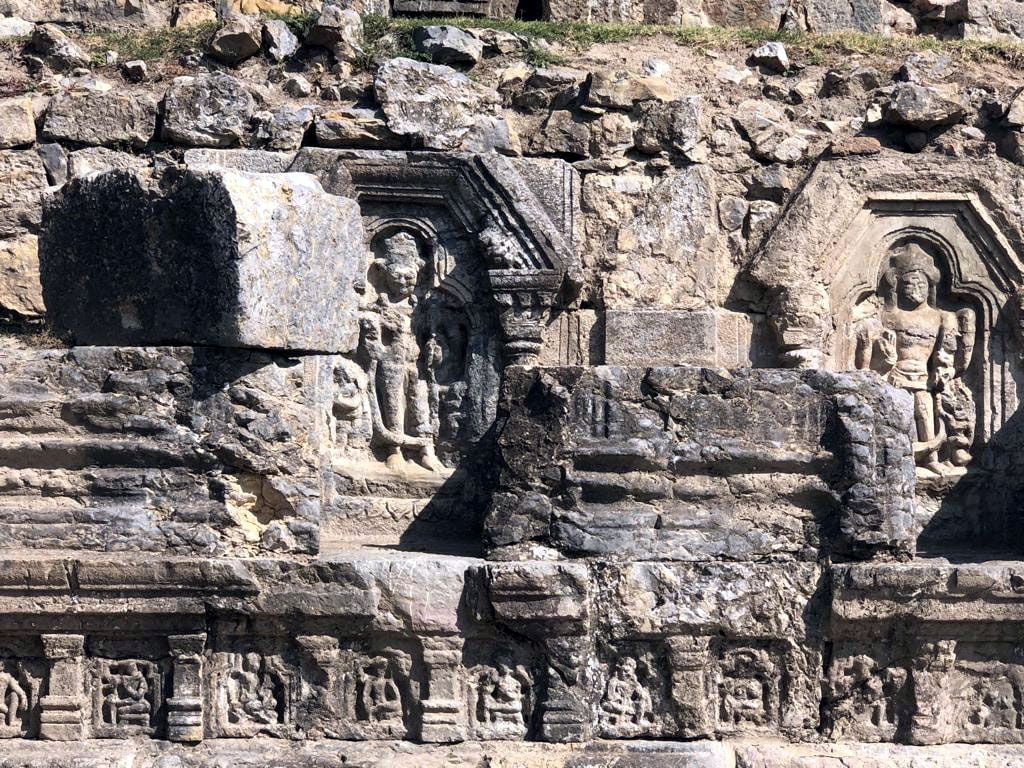
Legend of Martand Sun Temple:
Foundation and Patronage:
- Lalitaditya Muktapida: The most common legend attributes the temple’s construction to King Lalitaditya Muktapida of the Karkota Dynasty in the 8th century AD. Some believe he built it to honor Surya, the Sun God, while others say it was a tribute to fishermen, a crucial profession during his reign.
- Gonanda Dynasty Contribution: Another legend suggests the foundation was laid even earlier, around 350-500 CE, by the Gonanda Dynasty, with Lalitaditya completing the construction as an act of devotion.
Destruction and Curse:
- Sikandar Butshikan’s Fury: The most tragic legend relates to the temple’s destruction in the 15th century by Sultan Sikandar Butshikan. Driven by religious zeal, he allegedly ordered the demolition, earning him the title “Butshikan” (idol-breaker). Some versions claim he had the temple set on fire, while others say it took a year to dismantle with dedicated teams.
- Curse of Lalitaditya: A powerful curse supposedly placed by Lalitaditya predicted misfortune for any ruler who destroyed the temple. Some believe Sikandar Butshikan’s short reign and violent death fulfilled this curse.
Other Legends:
- Miraculous Idol of Surya: One legend tells of a life-size, luminous idol of Surya placed within the temple. When Sikandar’s men tried to remove it, they were blinded by its radiant light. Another version says the idol vanished miraculously.
- Hidden Treasure: Whispers exist about hidden treasure buried beneath the temple ruins, guarded by spirits. However, this remains speculation with no confirmed findings.
Read More>> Mahamaya Shakti Peeth Amarnath
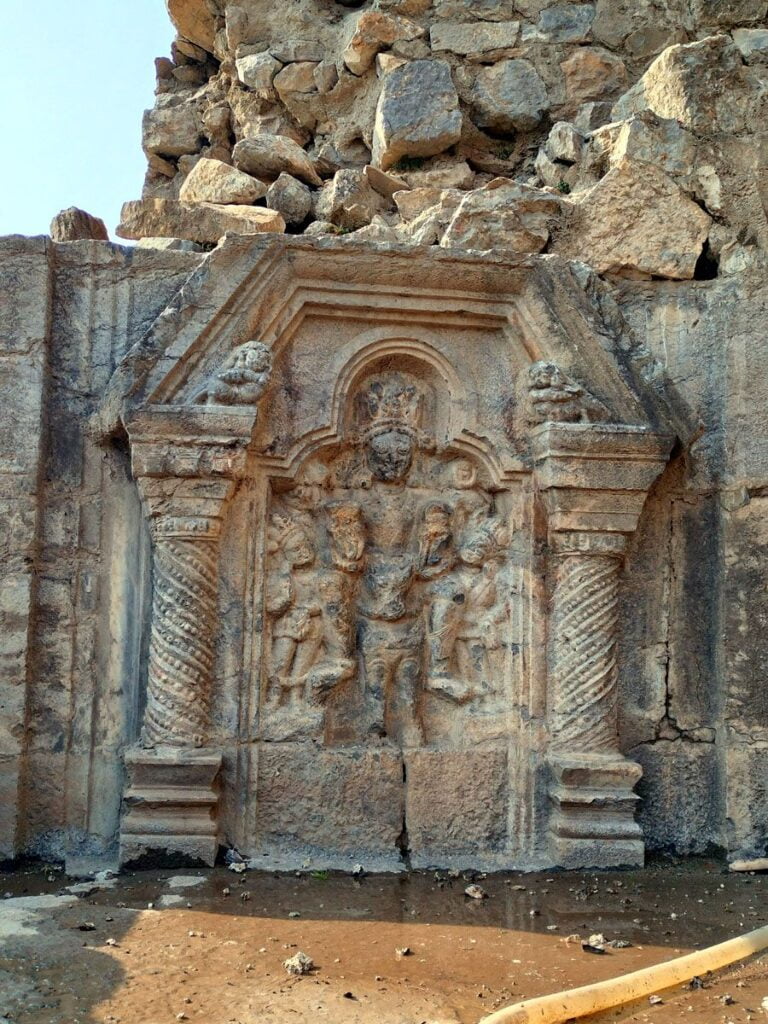
Significance of Martand Sun Temple:
The Martand Sun Temple holds significance on several levels:
Historical:
- Age and Dynasty: Built in the 8th century AD, the temple stands as a testament to the architectural prowess and cultural vibrancy of the Karkota dynasty during their reign in Kashmir.
- Religious Importance: Dedicated to Surya, the chief sun god in Hinduism, the temple served as a major pilgrimage site for centuries, attracting devotees from across the region.
- Symbol of Religious Persecution: The brutal destruction of the temple in the 15th century by Sultan Sikandar Butshikan serves as a poignant reminder of religious persecution and the fragility of cultural heritage.
Architectural:
- Style and Influences: Though currently in ruins, the temple showcased a unique blend of Gandharan, Gupta, and Chinese architectural styles, highlighting the cultural exchange and artistic diversity of the era.
- Engineering Marvel: Built on a plateau with panoramic views, the temple’s design and construction techniques displayed the advanced engineering skills of the time.
- Artistic Expression: The carvings and sculptures, though partially damaged, provide insights into the artistic traditions and symbolism prevalent during the temple’s heyday.
Cultural:
- Kashmiri Identity: The temple stands as a powerful symbol of Kashmiri cultural heritage and religious history, fostering a sense of identity and connection to the past.
- Tourist Attraction: Despite its ruined state, the temple remains a significant tourist attraction, drawing visitors interested in history, architecture, and cultural understanding.
- Conservation Efforts: The ongoing restoration efforts by the Archaeological Survey of India highlight the value placed on preserving this important historical and cultural landmark.
Read More>> Divine Mata Vaishno Devi Temple
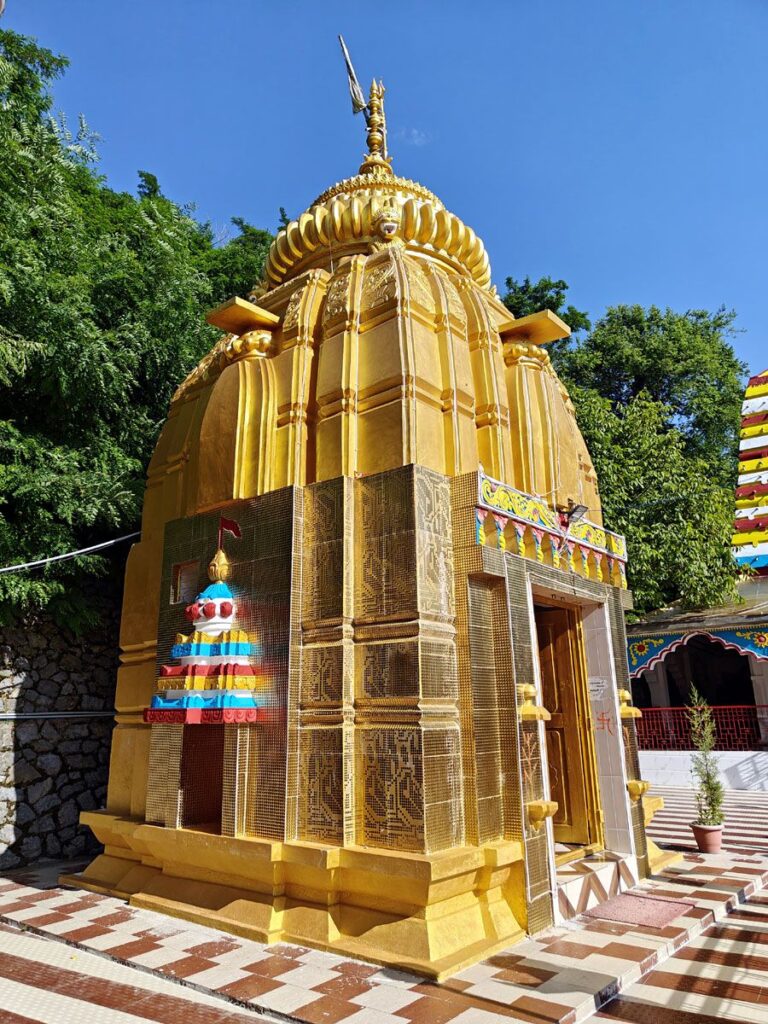
Martand Sun Temple Architecture:
A Fusion of Styles:
The Martand Sun Temple, also known as Pandou Laidan, stands as a testament to the architectural brilliance of its era. Built in the 8th century AD, the temple showcases a unique blend of influences, harmoniously incorporating elements from Gandharan, Gupta, and Chinese architectural styles. This fusion resulted in a structure that was both aesthetically pleasing and functionally sound.
Layout and Design:
The temple is situated atop a plateau, offering breathtaking views of the surrounding Kashmir Valley. The complex features a central courtyard surrounded by a colonnade, with 84 smaller shrines encircling the main sanctuary. This layout, known as a peristyle, is considered the largest of its kind in Kashmir.
The Central Shrine:
The heart of the temple is the central shrine, a pyramidal structure that embodies the typical Kashmiri temple architecture. Intricate carvings adorn the shrine’s exterior, depicting various deities and mythological scenes. The entrance faces west, aligning with the setting sun, symbolizing the temple’s dedication to Surya, the Sun God.
Other Notable Features:
- Proportional Chambers: The various chambers within the temple complex are meticulously proportioned, creating a sense of balance and harmony.
- Water Management System: An ingenious water management system, featuring a central tank and narrow channels, ensured the temple’s water supply.
- Sculptures and Reliefs: Exquisite sculptures and reliefs depicting Hindu deities and mythological figures adorn the temple walls, adding to its artistic richness.
A Legacy in Stone:
Despite facing destruction over the centuries, the Martand Sun Temple continues to stand as a remarkable example of ancient Indian architecture. Its unique blend of styles, intricate carvings, and well-planned layout serve as a reminder of the artistic and engineering prowess of its builders.
Read More>> Konark Sun Temple 13th Century Gem
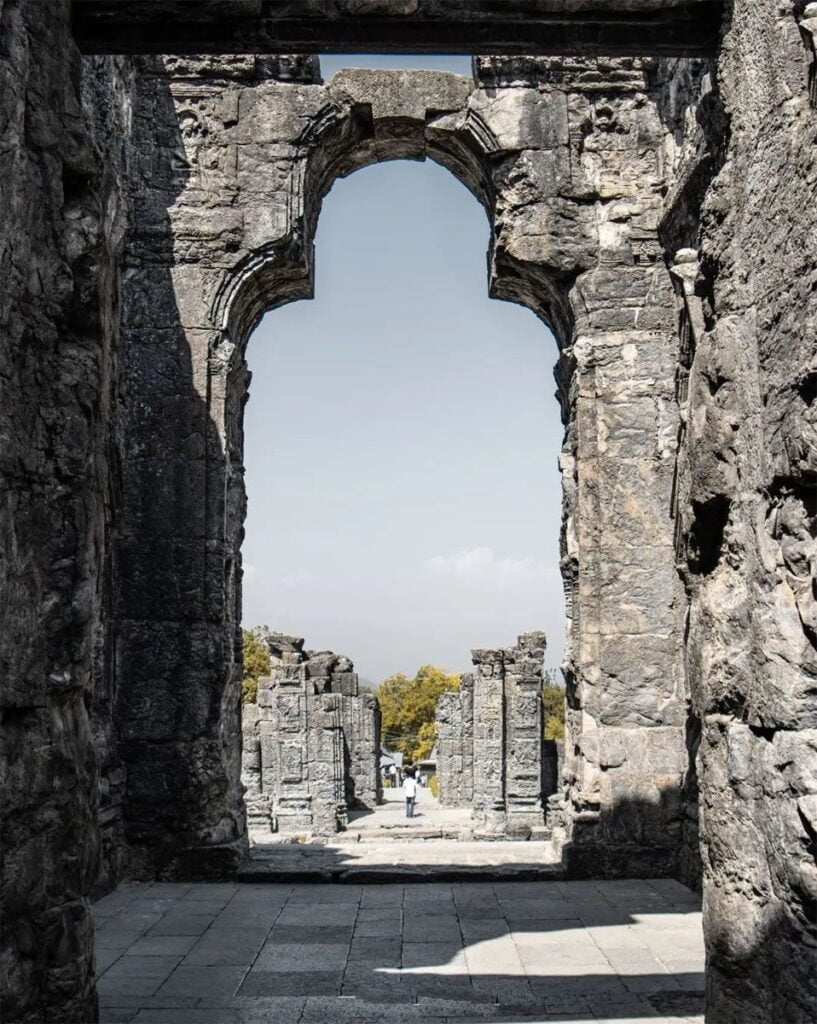
Places to visit near Martand Sun Temple:
- Anantnag: The town of Anantnag itself has various attractions, including the famous springs of Verinag and Achabal, which are known for their picturesque beauty.
- Pahalgam: Located about 40 kilometers from Anantnag, Pahalgam is a popular tourist destination known for its stunning landscapes, Lidder River, and as a base for the Amarnath Yatra pilgrimage.
- Aru Valley: A scenic valley near Pahalgam, Aru Valley is known for its meadows, snow-capped peaks, and trekking opportunities.
- Betaab Valley: Named after the Bollywood movie Betaab, this valley is surrounded by snow-capped mountains and lush greenery, providing a tranquil setting.
- Sheshnag Lake: Located at a higher altitude, Sheshnag Lake is known for its pristine blue waters and is a popular trekking destination.
- Amarnath Cave: Famous for the annual Amarnath Yatra pilgrimage, the Amarnath Cave is dedicated to Lord Shiva and is surrounded by breathtaking mountain scenery.
- Martand Plateau: Explore the Martand Plateau itself, where the Sun Temple is situated. Enjoy the scenic views of the surrounding mountains and valleys.
- Verinag: Visit the Verinag Spring, the source of the Jhelum River, which is known for its Mughal-style garden and historical significance.
- Achabal Gardens: These Mughal gardens near Anantnag are known for their terraced layout, fountains, and beautiful landscaping.
- Daksum: A charming town near Anantnag, Daksum is surrounded by dense forests and offers a peaceful retreat for nature lovers.
FAQ:
What is the Martand Sun Temple?
The Martand Sun Temple, also known as the Surya Devalaya, is an ancient Hindu temple dedicated to Surya, the Sun God. It is located in the Anantnag district of Jammu and Kashmir, India, on a plateau offering stunning views of the Kashmir Valley. The temple dates back to the 8th century AD and is renowned for its unique architectural style, blending influences from Gandharan, Gupta, and Chinese traditions.
Who built the Martand Sun Temple?
The temple is believed to have been built by King Lalitaditya Muktapida, the third ruler of the Karkota Dynasty, sometime in the 8th century AD.
What happened to the Martand Sun Temple?
Unfortunately, the temple was destroyed by Sultan Sikandar Butshikan in the 15th century. Though in ruins, the site still retains its impressive scale and intricate carvings, offering a glimpse into its past glory.
Is the Martand Sun Temple open to the public?
Yes, the Martand Sun Temple is open to the public and accessible 24 hours a day, 7 days a week.
What are the best times to visit the Martand Sun Temple?
The best time to visit the temple depends on your preference. Sunrise and sunset offer breathtaking views of the valley bathed in golden light, while daytime provides better visibility for exploring the ruins.
What is there to see at the Martand Sun Temple?
Although in ruins, the temple complex still boasts impressive features such as:
- The central sanctuary: Dedicated to Surya, it was once adorned with a massive statue of the Sun God.
- Colonnaded courtyard: Surrounding the central sanctuary, it provided space for rituals and gatherings.
- 84 smaller shrines: These once housed other deities and statues, showcasing the temple’s vastness.
- Intricate carvings: Depicting various deities, flora, and geometric patterns, these offer a glimpse into the artistic prowess of its builders.
What are some things to keep in mind when visiting the Martand Sun Temple?
- Dress modestly and respectfully, covering your shoulders and knees.
- Be mindful of your footwear as the terrain can be uneven.
- Maintain silence and avoid disturbing others praying or meditating.
- Photography is permitted, but refrain from using flash inside the ruins.
- Leave no trace and help preserve the site’s historical significance.
Are there any festivals or events associated with the Martand Sun Temple?
While no active worship takes place currently, the temple complex does hold cultural significance for the local community. Occasionally, cultural events or prayers are held on special occasions.
Is there any place to stay near the Martand Sun Temple?
Several hotels and guesthouses are available in the nearby town of Anantnag, offering different options to suit your budget and preferences.
How to reach Martand Sun Temple:
- By Air: The nearest airport is Sheikh ul-Alam International Airport in Srinagar, which is approximately 68 kilometers away from Anantnag. From the airport, you can hire a taxi or use other local transportation to reach the temple.
- By Train: The nearest major railway station is Jammu Tawi Railway Station. From there, you can hire a taxi or use buses to reach Anantnag. The temple is further accessible by local transportation from Anantnag.
- By Road: Anantnag is well-connected by road to various cities in Jammu and Kashmir. You can use buses or hire a taxi to reach Anantnag. From Anantnag, you can then hire a local taxi or use other means of transportation to reach the Martand Sun Temple.
